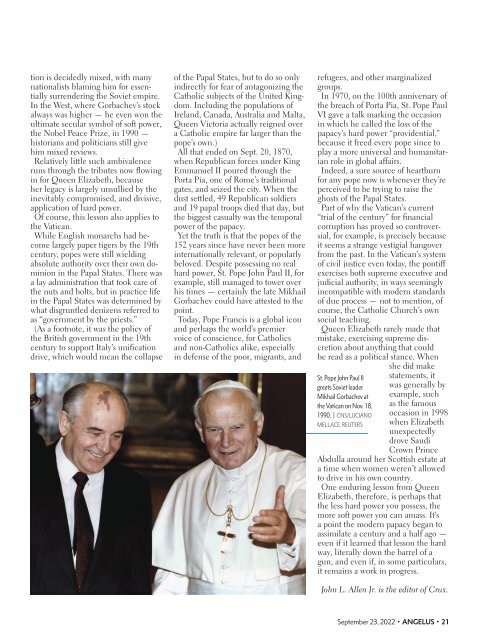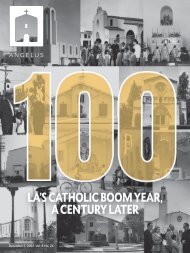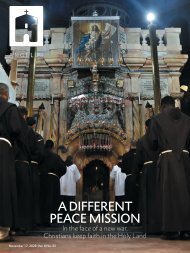Angelus News | September 23, 2022 | Vol. 7 No. 19
On the cover: The logo used for the Catechism of the Catholic Church, published in 1992, is adapted from an image found in the Catacombs of Domitilla in Rome thought to symbolize “the rest and the happiness that the soul of the departed finds in eternal life.” Ahead of the 30th anniversary of the catechism’s release next month, Russell Shaw explains on Page 10 what prompted the Church to undertake such an immense project. On Page 26, Greg Erlandson offers a perspective on the text’s relevance to ordinary Catholics — like his own mother.
On the cover: The logo used for the Catechism of the Catholic Church, published in 1992, is adapted from an image found in the Catacombs of Domitilla in Rome thought to symbolize “the rest and the happiness that the soul of the departed finds in eternal life.” Ahead of the 30th anniversary of the catechism’s release next month, Russell Shaw explains on Page 10 what prompted the Church to undertake such an immense project. On Page 26, Greg Erlandson offers a perspective on the text’s relevance to ordinary Catholics — like his own mother.
Create successful ePaper yourself
Turn your PDF publications into a flip-book with our unique Google optimized e-Paper software.
tion is decidedly mixed, with many<br />
nationalists blaming him for essentially<br />
surrendering the Soviet empire.<br />
In the West, where Gorbachev’s stock<br />
always was higher — he even won the<br />
ultimate secular symbol of soft power,<br />
the <strong>No</strong>bel Peace Prize, in <strong>19</strong>90 —<br />
historians and politicians still give<br />
him mixed reviews.<br />
Relatively little such ambivalence<br />
runs through the tributes now flowing<br />
in for Queen Elizabeth, because<br />
her legacy is largely unsullied by the<br />
inevitably compromised, and divisive,<br />
application of hard power.<br />
Of course, this lesson also applies to<br />
the Vatican.<br />
While English monarchs had become<br />
largely paper tigers by the <strong>19</strong>th<br />
century, popes were still wielding<br />
absolute authority over their own dominion<br />
in the Papal States. There was<br />
a lay administration that took care of<br />
the nuts and bolts, but in practice life<br />
in the Papal States was determined by<br />
what disgruntled denizens referred to<br />
as “government by the priests.”<br />
(As a footnote, it was the policy of<br />
the British government in the <strong>19</strong>th<br />
century to support Italy’s unification<br />
drive, which would mean the collapse<br />
of the Papal States, but to do so only<br />
indirectly for fear of antagonizing the<br />
Catholic subjects of the United Kingdom.<br />
Including the populations of<br />
Ireland, Canada, Australia and Malta,<br />
Queen Victoria actually reigned over<br />
a Catholic empire far larger than the<br />
pope’s own.)<br />
All that ended on Sept. 20, 1870,<br />
when Republican forces under King<br />
Emmanuel II poured through the<br />
Porta Pia, one of Rome’s traditional<br />
gates, and seized the city. When the<br />
dust settled, 49 Republican soldiers<br />
and <strong>19</strong> papal troops died that day, but<br />
the biggest casualty was the temporal<br />
power of the papacy.<br />
Yet the truth is that the popes of the<br />
152 years since have never been more<br />
internationally relevant, or popularly<br />
beloved. Despite possessing no real<br />
hard power, St. Pope John Paul II, for<br />
example, still managed to tower over<br />
his times — certainly the late Mikhail<br />
Gorbachev could have attested to the<br />
point.<br />
Today, Pope Francis is a global icon<br />
and perhaps the world’s premier<br />
voice of conscience, for Catholics<br />
and non-Catholics alike, especially<br />
in defense of the poor, migrants, and<br />
refugees, and other marginalized<br />
groups.<br />
In <strong>19</strong>70, on the 100th anniversary of<br />
the breach of Porta Pia, St. Pope Paul<br />
VI gave a talk marking the occasion<br />
in which he called the loss of the<br />
papacy’s hard power “providential,”<br />
because it freed every pope since to<br />
play a more universal and humanitarian<br />
role in global affairs.<br />
Indeed, a sure source of heartburn<br />
for any pope now is whenever they’re<br />
perceived to be trying to raise the<br />
ghosts of the Papal States.<br />
Part of why the Vatican’s current<br />
“trial of the century” for financial<br />
corruption has proved so controversial,<br />
for example, is precisely because<br />
it seems a strange vestigial hangover<br />
from the past. In the Vatican’s system<br />
of civil justice even today, the pontiff<br />
exercises both supreme executive and<br />
judicial authority, in ways seemingly<br />
incompatible with modern standards<br />
of due process — not to mention, of<br />
course, the Catholic Church’s own<br />
social teaching.<br />
Queen Elizabeth rarely made that<br />
mistake, exercising supreme discretion<br />
about anything that could<br />
be read as a political stance. When<br />
she did make<br />
St. Pope John Paul II<br />
greets Soviet leader<br />
Mikhail Gorbachev at<br />
the Vatican on <strong>No</strong>v. 18,<br />
<strong>19</strong>90. | CNS/LUCIANO<br />
MELLACE, REUTERS<br />
statements, it<br />
was generally by<br />
example, such<br />
as the famous<br />
occasion in <strong>19</strong>98<br />
when Elizabeth<br />
unexpectedly<br />
drove Saudi<br />
Crown Prince<br />
Abdulla around her Scottish estate at<br />
a time when women weren’t allowed<br />
to drive in his own country.<br />
One enduring lesson from Queen<br />
Elizabeth, therefore, is perhaps that<br />
the less hard power you possess, the<br />
more soft power you can amass. It’s<br />
a point the modern papacy began to<br />
assimilate a century and a half ago —<br />
even if it learned that lesson the hard<br />
way, literally down the barrel of a<br />
gun, and even if, in some particulars,<br />
it remains a work in progress.<br />
John L. Allen Jr. is the editor of Crux.<br />
<strong>September</strong> <strong>23</strong>, <strong>2022</strong> • ANGELUS • 21


















